Bhendi is one of India’s most common vegetables. Asra-pattraka (Sanskrit), Bhindi (Hindi), Dhenras (Bengali), Vendai (Tamil), Bhindi (Gujarati), Bendekayi (Kannada), Ventayakka (Malayalam), and Bhindi (Hindi) are some of the common names for the plant. Having 3 to 5 lobed palmately cordate leaves, it is an annual, erect herb that grows to 0.9 to 2.1 meters in height. Plants produce pyramidal pods between 12.5 and 30 cm in length. Okra is mainly grown for its green, tender edible fruits.
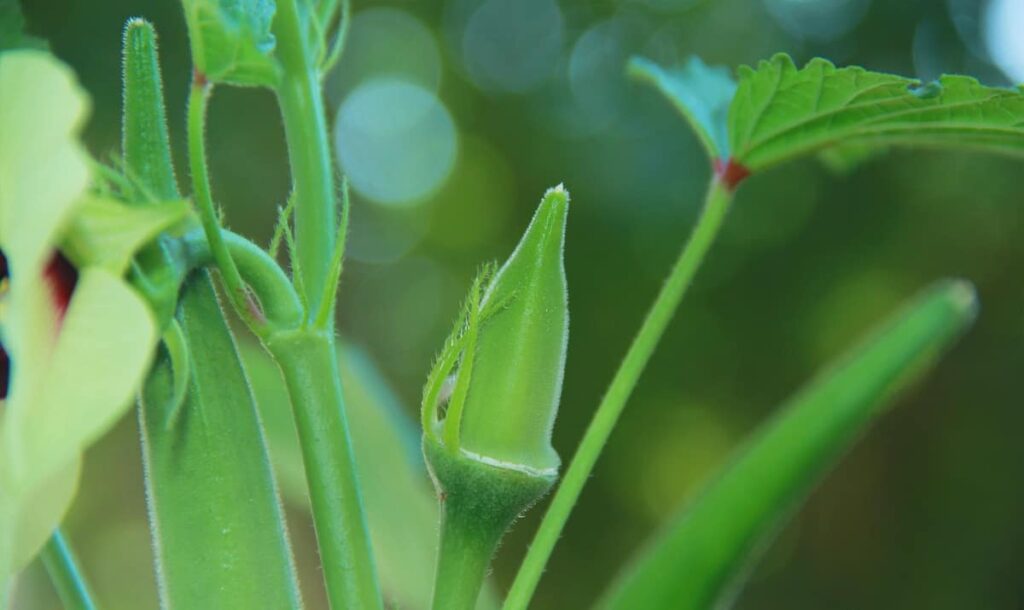
It is possible to extract fiber from dry fruits and skins. In addition to vitamins, protein, calcium, and other minerals, Okra is a rich source of fiber. Despite its Ethiopian origins, it is mainly grown in tropical and subtropical regions. There are five major Okra growing states in India: Uttar Pradesh, Bihar, West Bengal, Tamil Nadu, and Orissa. Okra is widely cultivated in Vellore, Salem, Coimbatore, and Dindigul in Tamilnadu, and its major markets include Periyar Vegetable Market Koyambedu, Chennai Gandhi Market, Oddanchathiram, and Natchipalayam vegetable market.
Growing Okra organically in Tamil Nadu
How the Tamilnadu government supports organic farming
The horticulture department supports organic farming at every stage of the production cycle and helps farmers market their products across India with a single certificate under the “Tamil Nadu Organic Farming Mission.” Farmers interested in organic farming will also be encouraged to form 150 clusters covering an area of 7,500 acres under Paramparagat Krishi Vikas Yojana, a Rs. 5 crores Central scheme that both the Centre and the State will fund.
To facilitate access to quality seeds and provide advisory on seed production and certification of organic crops, an Integrated Seed Certification Office Complex that will help with seed certification, inspection, and testing will be established. To reduce the certification cost and marketing of organic crops, a participatory guarantee system (PGS) is introduced to facilitate the marketing of organic produce across India without incurring additional certification expenses.
Varieties for organic farming of bhendi
Pusa Sawani, developed as an open-pollinated variety, prevailed across the country for over two decades. However, with the breakdown of its tolerance to yellow vein mosaic virus, around fifteen to twenty varieties have been developed by different organizations and released for cultivation. Today’s popular okra varieties are Arka Anamika, Pusa Sawani, Pharbhani Kranti, Janardhan, VRO-5, Pusa Mukhmali, Varsha Uphar, VRO-6, Pusa A-4, and Utakal Gaurav, etc.
In case you missed it: Growing Red Chilli Organically in Andhrapradesh: Farming Practices and Production Management
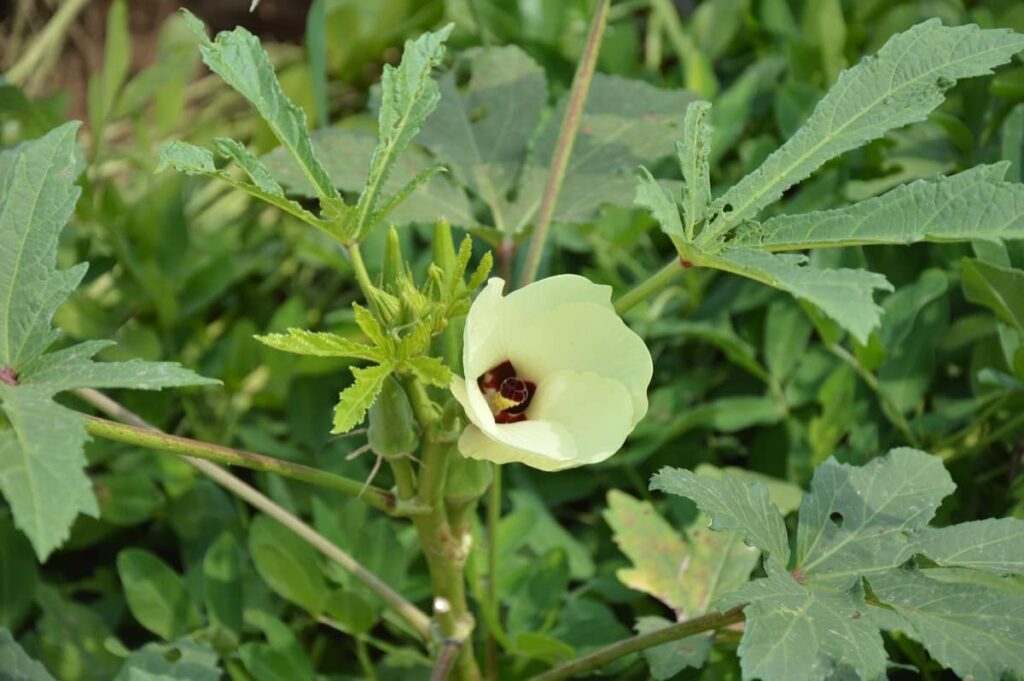
Besides these, local varieties are still being grown, particularly by organic farmers. Some of the popular local varieties of Tamil Nadu are Bangalore local, Kulemagali Vendai, and Nattu vendai (JRDP). The selection of organic farming varieties should be based on disease and pest resistance, among other specifications.
Pusa Sawani: It is developed by IARI, New Delhi. Suitable for cultivation in summer and rainy seasons. Ready to harvest within 50 days. Fruits are dark green and 10-12cm long at harvesting time. It is susceptible to the yellow vein mosaic virus. This variety gives an average yield of 48-60 qtl/acre.
Punjab no.13: Developed by Punjab Agricultural University, Ludhiana. It is suitable for cultivation in spring as well as in summer. Fruits are light green and medium size. It is susceptible to the yellow vein mosaic virus.
Punjab Padmini: Developed by Punjab Agricultural University, Ludhiana. Fruits are quick growing, hairy, and of dark green color. Ready to harvest within 55-60 days after sowing. It is tolerant to the yellow vein mosaic virus. This variety gives an average yield of 40-48qtl/acre.
Punjab 7: It is resistant to yellow vein mosaic virus, jassid, and bollworm. Fruits are dark green and medium in size. This variety gives an average yield of 40 qtl/acre.
Punjab 8: It was developed from Pusa Sawani. When fruit is harvested, it is dark green and measures 15-16 cm long. In addition to being resistant to yellow vein mosaic virus, it is also resistant to fruit borer.
Punjab Suhavani: It gives an average yield of 49qtl/acre. It has dark green color fruits and is tolerant to the yellow mosaic virus.
Climate requirements for cultivating Okra organically
Bhendi is a tropical vegetable and requires a long, warm, and humid growing period. It grows even at an altitude of 1,200 m. It thrives well in hot, humid areas and is well suited for tropical and subtropical regions. Temperatures between 24°C and 28°C are preferred for normal growth and development. Higher temperatures help in faster plant growth though they may delay fruiting.
However, very high temperatures are unfavorable, and flowers drop below 40–42°C, causing yield loss. Therefore, changing climatic factors help to take one (summer) crop in the hills, two or even three (summer, Kharif, and late Kharif) crops in east, west, and north India, and almost year-round cultivation under a moderate climate in south India.
Soil requirements and land preparation for cultivating Okra organically
The crop is adapted to various soils, from sandy to clayey. But loamy soils are preferred due to their well-developed tap root system, relatively light, well-drained, loose, friable, and well-manured. A pH between 6–6.8 is ideal. Before sowing, enrichment with organic manure is needed for all soil types. Okra can also be grown in mild salt-affected soils.
The land is prepared by plowing it five or six times deep and leveled by planking twice or three times. When plowing, apply 100 qtl of well-decomposed cow dung per acre. A ridge-and-furrow layout is used. Occasionally, Okra is also sown at the border of the main crop, and the layout is the same. Directly sow the seeds in soil 1.5 to 2 cm deep by seed drill, hand dibbling, or behind the plow.
Seed selection and treatment for cultivating Okra organically
Seeds can be procured from a certified organic farm or a self-plot. In the case of a self-plot, care should be taken to isolate the plants from contamination and selection of disease and pest-free sources. Once the pods are mature, dry, and start cracking, they can be harvested. To sow in 1 acre of field, about 120 plants are to be isolated. A 9 kg/acre seed rate for a summer crop and 5 kg/acre for a rain-fed crop is optimal.
In case you missed it: Growing Onions Organically in Maharashtra: Cultivation Practices and Production Management
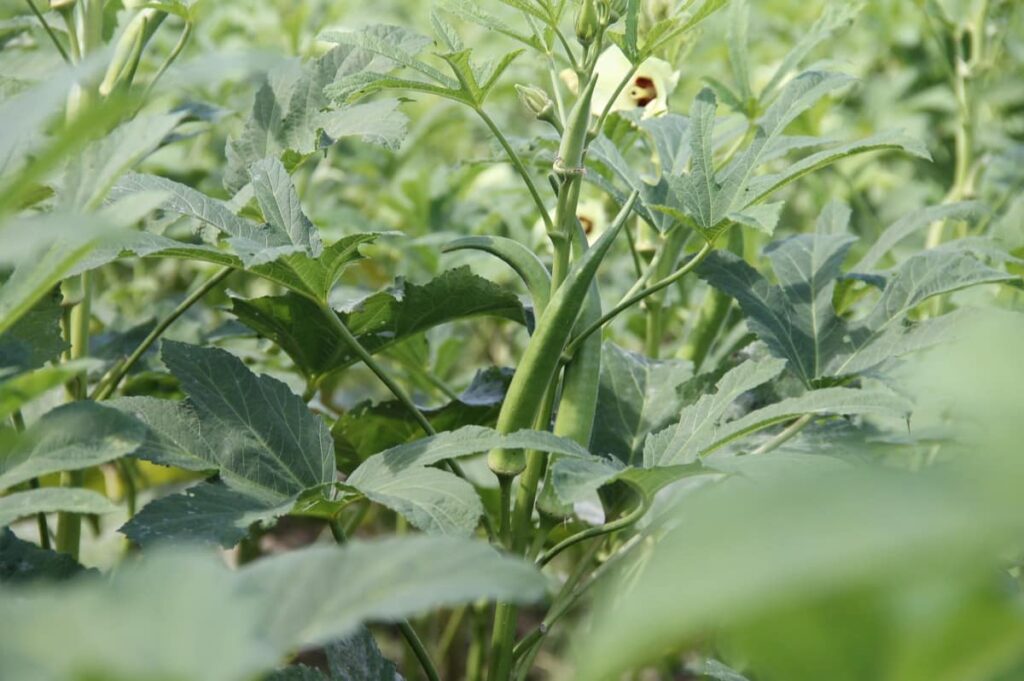
It is essential to treat seeds not only as a preventive measure but also to aid in germination. When cultivating in the summer, it is recommended that seeds be soaked for 12 hours before sowing. Before sowing, sweet flag rhizome extract is applied to seeds for 30 minutes to give them resistance to fungal and bacterial diseases. After soaking in water for eight hours, seeds can be treated with Jeevamrut for 4-6 hours, shade dried, and sown.
Sowing and spacing for cultivating Okra organically
Okra seed sowing is done by dibbling or using a seed drill or plow. Broadcasting of okra seeds is not common. Ensure proper drainage, reduced water requirement, good germination, and ridge sowing are adopted. Seeds are dibbled at the rate of 2-3 per hole. The spacing specification changes with varieties; however, ridge-to-ridge spacing is recommended at 45 cm. The general spacing for branching varieties if 60cm x 30 cm, and for hybrids is 75 cm x 30 cm.
The growing season for Okra cultivation
The summer crop is sown from February to March and harvested between April and June. The rainy season crop is sown during June–July with the onset of rains and harvested between August–October. For the summer crop, early maturing five-ribbed cultivars with smooth pods are preferred and for the rainy season, late maturing five to eight-ribbed cultivars with smooth or hairy pods are grown. However, a few cultivars are suited for both seasons. The total crop duration is between 90 and 120 days.
Irrigation requirements in Okra cultivation
Depending on the season and the soil type, bhendi crops require different irrigation levels. In high-rainfall areas, where rainfall distribution is uniform across the growing season, bhendi is grown without irrigation during the rainy season. Immediately after seed sowing, light irrigation is given to ensure good germination. During summer, the crop is irrigated every 4-5 days. Fruit quality and yield are reduced by moisture stress during fruit setting. Therefore, a furrow irrigation method is usually used to irrigate the crop.
Fertilization in Okra cultivation
You need rich, well-draining soil with lots of organic matter to get the most production. But even if you’re blessed with good soil, amending it with a well-balanced fertilizer can make the difference between a decent harvest and a huge bumper crop. Three split applications of organic fertilizer during planting, 30 days after transplanting, and after the first harvest (3 t/acre)
Weed control in Okra cultivation
Keeping the crop weed-free for the first 20-25 days after planting is essential. A total of three to four weedings is necessary after that. Consequently, the first weeding occurs two weeks after seedling germination, followed by subsequent weedings once every 25 days. On the one hand- weeding effectively controls weed growth 20-25 days after sowing.
Major Pests in Okra farming
Shoot and fruit borer
Damage symptoms
- The larva bores into tender terminal shoots in the vegetative stage and flower buds, flowers, and young fruits in the fruit formation stage.
- The damaged shoots droop, wither and dry up. As a result, the infested fruits present a deformed appearance and become unfit for consumption.
Control and management
- Early sowing of okra seeds to avoid damage during rains
- Summer plowing and Soil sterilization
- Spraying ginger, garlic, and Chilli extract
- Set up pheromone trap at 5/acre.
- Collection and destruction of affected fruits
- Release of egg parasite Trichogramma chilonis at 40000/acre.
- Release of 1st instar larvae of green lacewing predator Chrysoperla carnea at 4000/acre.
In case you missed it: Growing Spinach Organically in Telangana: Cultivation Practices and Production Guide
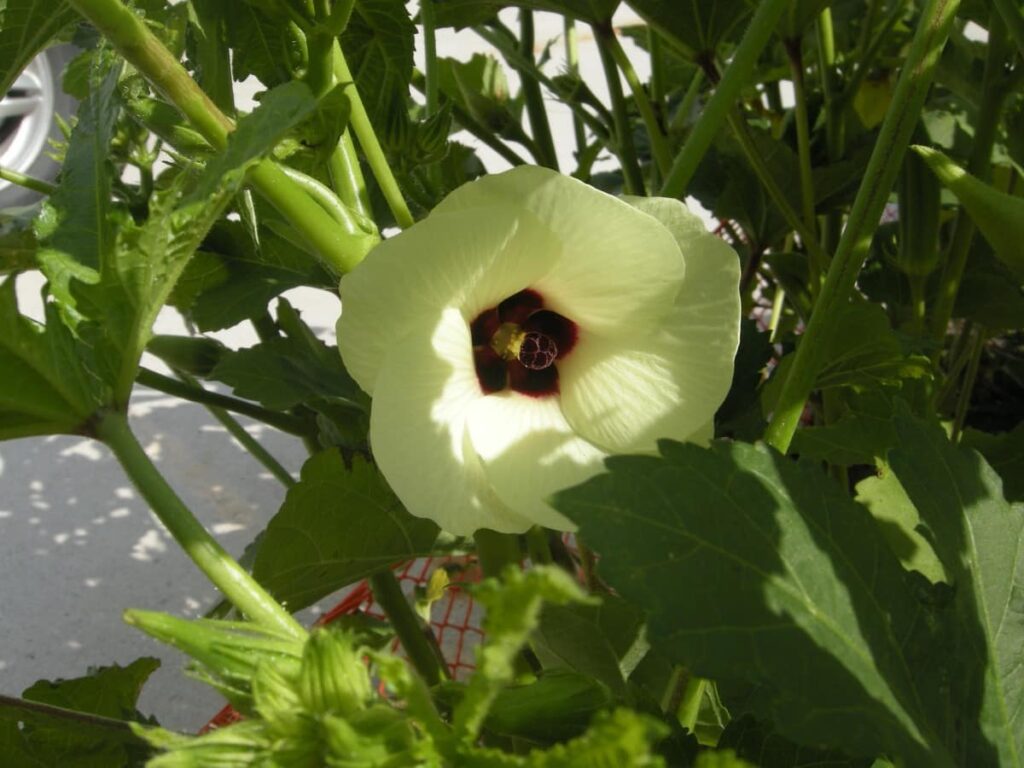
Leaf hoppers
Damage symptoms
- Affected leaves become yellow, crinkle around the margin, and show curling upward.
- Leaf tips and margins become necrotic.
- Severely infested leaves may become bronzed and look burn-like, and plants may become stunted.
Control and management
- Installation of yellow sticky traps (12/acre)
- Spraying 5% needs seed kernel extract
- Monitor the area regularly.
- Use of resistant varieties, if available.
- Intercrop with sunflower, green gram (Vigna radiata), and black gram (Vigna mungo).
- Prune infested leaves and dispose of them properly.
Fruit borers
Damage symptoms
- A circular borehole is drilled into the fruit, and flowers are fed on
- Larvae thrust only a part of their bodies into the fruit feed
Control and management
- Summer plowing
- Installation of bird perches and use of bird attractants to attract predatory birds
- Fenugreek flour (1 kg) + 2 liters of water. Mix them and keep them aside for 24 hours. Afterward, dilute with 40 liters of water and spray on crops.
- Collect and destroy the infected fruits and grown-up larvae
- Grow simultaneously 40 days old American tall marigolds and 25 days old tomato seedlings at 1:10 rows to attract Helicoverpa adults for egg laying.
In case you missed it: Fertilizer Schedule for Okra: Organic, Chemical, How and When to Apply
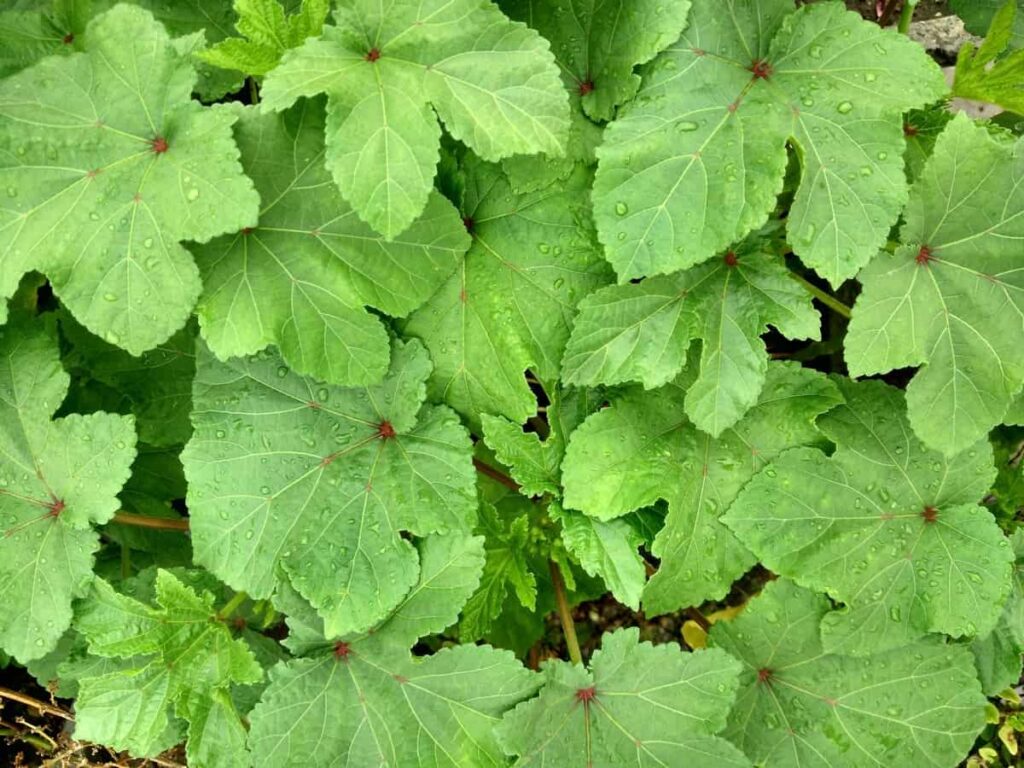
Major diseases in okra farming
Yellow vein mosaic/ Vein clearing
Damage symptoms
- A yellowing of the leaf blade’s veins characterizes this condition.
- During severe infections, the younger leaves turn yellow, become smaller, and the plant is severely stunted.
- As a result of the virus, the veins of the leaves will be cleared, and the interveinal area will be completely yellow or white.
- Infection can restrict flowering and result in smaller and harder fruits.
- Fruits produced by the affected plants are yellow or white and are unmarketable.
Control and management
- Cut a milk bush (Euphorbia tirucalli) or cactus (e.g., Euphorbia nivulia) into pieces, immerse it in water and allow fermentation for two weeks, after which filter the solution and spray on the crop
- Vector control using yellow sticky traps
- Weed hosts destruction in the vicinity of the crop
- Avoid planting during the hot season
- Use of resistant varieties like Arka Anamika, Pusa A-4, etc.
- The spray of 5% neem seed kernel extract
- By selecting varieties resistant to yellow vein mosaic, like Parbhani Kranti, Arka Abhay, Arka Anamika, and Varsha Uphar, the incidence of the disease can be minimized.
Cercospora leaf spot
Damage symptoms
- In India, two species of Cercospora produce leaf spots in bhendi.
- It causes brown, irregular spots, and C.abelmoschi causes sooty black, angular spots.
- Both leaf spots cause severe defoliation and are common during humid seasons.
Control and management
- The spray of 5% neem seed kernel extract
- Cleaning of bunds and Phyto-sanitation
Root-knot nematode
Damage symptoms
- There is often stunting and wilting of plants, especially under dry conditions.
- Chlorotic leaves and retarded growth may be observed.
- Seedlings that have been infested die in the seedbed and do not survive transplantation.
- Plants that survive have reduced flowering and fruit production.
Control and management
- The practice of crop rotation with cereals
- Use of marigold as an intercrop
- Addition of neem cake (25qtl/ha) to soil
- Use of bio-control agents Paecilomyces lilacinus, Bacillus penetrans
- Soil solarization with clear plastic tarps during summer.
In case you missed it: How to Start Organic Kodo Millet Cultivation from Scratch: Production and Cultivation Practices for Sowing to Harvesting
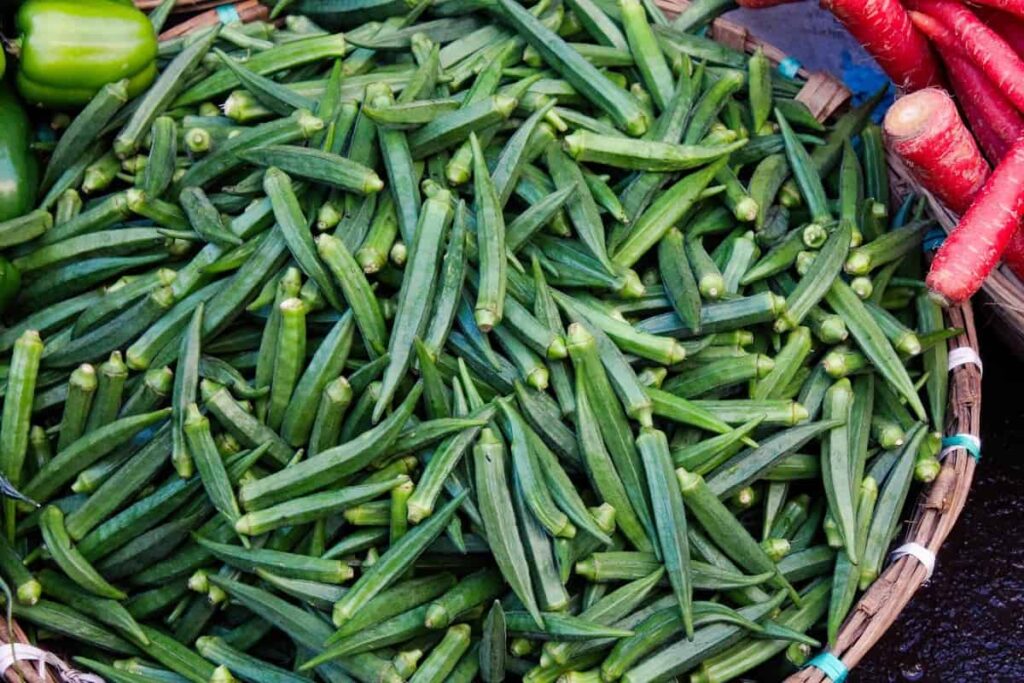
General management practices
- Mint leaf extract (250 g powder/2 liters of water) spray
- 5% neem seed kernel extract spray
- Fumigation with Embelia Ribes or Acorus calamus during evening hours
Harvesting
The harvesting period depends on various characteristics and ranges from 45-60 days after sowing. The pod size and stage depend on the market preference. Harvesting is normally conducted during morning hours. The variation in the maturity of fruits of the same crop influences frequents harvesting.
It also helps regulate pod size and maturity and enhances fruit formation. The harvest from mornings immediately goes to evening markets. The post-harvest handling of Okra for long-distance markets requires a cold chain facility, making it a delicate issue for small farmers. Okra generally yields 3-4 t/acre on average, while hybrid varieties reap 6-10 t/acre.
Conclusion
In India, many ICAR institutes, state agricultural universities, and private seed companies are working on various aspects of the genetic improvement of Okra to develop high-yielding and disease-resistant varieties. Some of these varieties and hybrids have already made significant impacts/contributions to revolutionizing the production of Okra in the country. If you live in the following districts, cities, and towns of Tamil Nadu, this article will help you grow organic Okra.
| Chennai/Madras | Pudukkottai |
| Madurai | Ambur |
| Coimbatore | Gudiyatham |
| Tiruchirappalli | Rameswaram |
| Erode | Thiruvarur |
| Thanjavur | Neyveli |
| Dindigul | Mayiladuthurai |
| Karaikudi | Valparai |
| Salem | Palani |
| Tirunelveli | Pollachi |
| Cuddalore | Krishnagiri |
| Karur | Sivakasi |
| Kumbakonam | Neyveli |
| Tiruppur | Komarapalayam |
| Vellore | Theni |
| Kodaikanal | Tenkasi |
| Thoothukudi | Namakkal |
| Hosur | Dharmapuri |
| Nagapattinam | Vaniyambadi |
| Nagercoil | Virudhunagar |
| Vellore | Chidambaram |
| Tiruvannamalai | Ranipet |
| Pudukkottai | Arani |
| Kanchipuram | Kanyakumari |
| Rajapalayam | Perambalur |
| Gudiyatham | Chettinad |
| Ooty | Chengalpattu |
| Ambur | Krishnagiri |
- Profitable Village Farming Business Ideas in 2024
- High-Yield Aquaculture: Fast-Growing Fish for Farming
- Effective Fish Pond Construction Techniques for Beginners
- Irrigation and Water Management in Pineapple Farming
- Blossom to Harvest: Mastering Flowering and Pollination in Papaya Farming
- Pig Fattening Essentials: From Selection to Sale for Beginners
- Raising Wagyu Cattle: A Complete Guide for Premium Beef Production
- Soil Types and Their Water Holding Capacity
- Optimizing Irrigation Schedules for Coconut Groves for Enhanced Yield
- Espresso Your Garden: Coffee Grounds for Healthier Acid-Loving Plants
- The Best Soil Mix for Snake Plants: How to Mix Your Own Snake Plant Soil
- Green Thumb Success: Expert Tips for Cultivating Greenhouse Beans All Year Round
- Bloom All Year Round: The Ultimate Guide to Indoor Hyacinth Care
- Eco-Friendly Gardening: How to Make Liquid Fertilizer from Kitchen Waste
- Ultimate Guide to Grow Anise in Pots: Explore Seed Propagation to Harvesting
- Guide to Raising Chester White Pigs: Discover Breed Facts to Growth Management
- Mastering the Elegance: The Ultimate Guide to Weeping Cherry Tree Care, Planting, and Maintenance
- Ultimate Guide to Planting Garlic in Grow Bags: Growing Strategies for Beginners
- How to Fix Spider Plant Leaf-Related Problems: Natural and Organic Remedies
- 10 Reasons Why Your Tulsi Plant is Shedding Leaves: Home Remedies and Solutions
- Optimizing Growth and Yield: The Advantages of Palm Bunch Ash Fertilizer
- Utilizing Neem Oil Extract as a Natural Pesticide for Hydrangea
- From Soil to Harvest: Various Ways in Which Farmers Can Use AI Tools
- Steps to Encourage and Induce Citrus Flowers: A Comprehensive Guide
- How to Fix Snake Plant Leaf-Related Issues: Natural and Organic Remedies
- Transform Your Garden into a Fragrant Oasis with Raat Ki Rani (Night Blooming Jasmine)
- Discover the Ideal Chicken Breeds for Philippine Farms
- How to Create a Poultry Egg Farm Business Plan for Profits
- Grow Lemon Cucumbers Like a Pro: Insider Techniques for Bountiful Yields
- Ultimate Guide to Caring for Your Pink Princess Philodendron: Tips for Thriving Variegation
- Areca Nut Profit Per Acre: Calculating Yield and Cost of Cultivation
- How Kaveri Chicken is Becoming a More Profitable Breed in Indian Backyards
- Transform Your Barn: 9 Steps to Convert a Horse Stall into a Chicken Coop
- Exploring Suffolk Sheep Disadvantages with Limitations and Challenges
- Guide to Solving Potted Lemon Tree Problems: How to Revive Lemon Tree in Containers
- Steps to Encourage Female Pumpkin Flowers: Best Strategies for More Flowers and High Yields

This is a very effective article. When we do intercropping how will we calculate the fertilisers quantity?